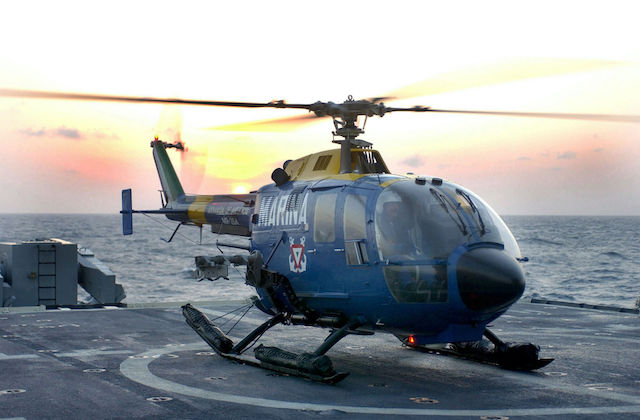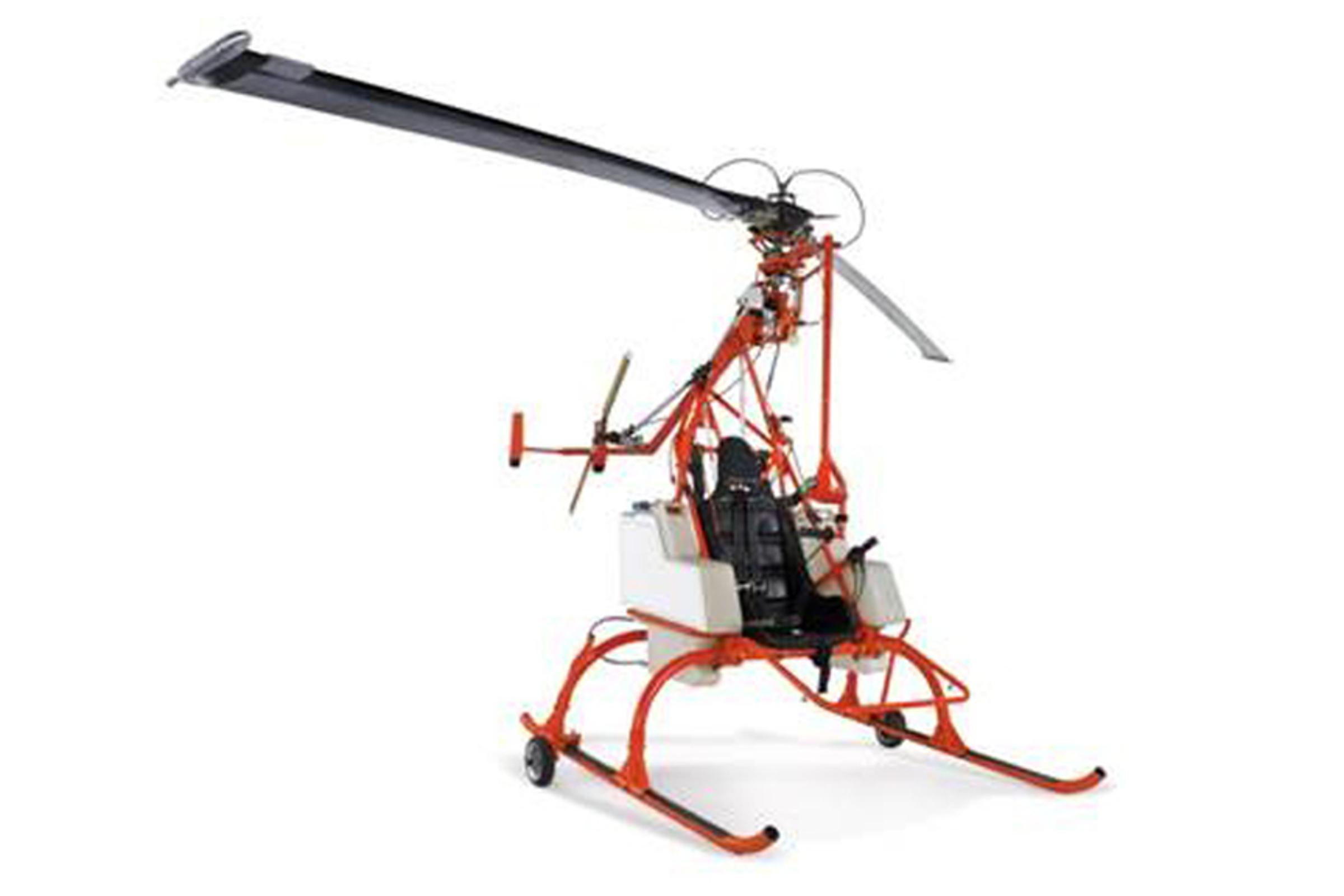Helicopters are incredible flying machines that test the limits of design and mechanics by their very existence. But which helicopters really test the limits of aviation? What about a helicopter that flies upside down? A helicopter that lifts far more than its own weight? Or a rotary machine that rivals jet airliners in size? These record-breaking helicopters will make your head spin!
10. Messerschmitt-Bölkow-Blohm Bo 105: Aerobat

The iconic steed of Red Bull pilots Chuck Aaron and his successor Aaron Fitzgerald, the Messerschmitt-Bölkow-Blohm Bo 105 was a revolutionary contribution to rotary aviation from Germany that stands out as a world first aerobatic helicopter. The machine was also new, as it was the first light twin-engine helicopter. That's right, this super-powerful helicopter can do barrel rolls, loops, and fly upside down like the most extreme stunt planes, thanks to its incredible design.
With the Bo 105's capabilities as the first helicopter in history to achieve these goals, the helicopter's flight range and intended utility as a machine were revolutionary. The hingeless rotor, machined from a single piece of titanium, is just one of the hallmarks of this engineering marvel. The machine can climb at 1,575 feet per minute and fly at 150 miles per hour, powered by two standard 420-horsepower Rolls Royce engines. The machines were manufactured primarily in Germany and Canada and used in a variety of roles, from military to police, as well as the famous inverted and rolling barrel air show demonstrations. The helicopter was also adapted for use on aircraft carriers and was even equipped with missiles.
9. Mile B-12: the biggest
How big can a helicopter be? Bigger than you'd imagine, rivaling jet airliners, yet barely recognizable to the casual eye as a horribly overgrown helicopter. First flight in 1968, just before the whole project was cancelled,Mil V-12 project of the Soviet Union before the cold war was built as a transport with a range of 621 miles and a capacity to carry 196 passengers or a huge load of military cargo. Weighing just over seventy-six American tons and capable of flying at 150 miles per hour, the largest helicopter in world history remains unrivaled.
Each rotor was only 220 feet in diameter, resembling a giant tube with long, airplane-like wings, each ending in a monstrous propeller blade, a monstrous whirlwind bird with two propellers dwarfed many aircraft. In 1971, the Soviet Union unveiled the monster at the Paris Air Show, astonishing onlookers who saw the helicopter, with its rotors and vertical lift capabilities, crossed with the appearance of an airliner. One reason for the Soviets’ exceptional helicopter development was the need to more efficiently transport giant missiles to remote launch sites, away from the eyes of Western spy planes. Trains were slow and couldn’t get to many places, but the enormous helicopters could.
8. Westland Lynx: the fastest helicopter

The world's fastest conventional helicopter may be unassuming, but it has held the official world helicopter speed record since 1986. The Westland Lynx achieved an average speed of just over 248 mph over Somerset, England, under the watch of the Fédération Aéronautique Internationale (FAI), which sets helicopter speed records for maximum speed , achieved by a helicopter in the 3,000–4,500 kg (6,613.868–99,208 lb) weight class, and the absolute world record for a rotorcraft. The achievements may have been made decades ago, but have yet to be surpassed, as faster rotorcraft have not since been classified as true helicopters, but are instead forward-engine hybrid aircraft such as tiltrotor aircraft.
Westland Lynx's record-breaking installation used specialised main blades , designed to combat stalling blades that would degrade during high-speed flight is a design undertaking undertaken by the UK Experimental Rotor Programme. This programme was a joint effort between Westland and the UK Ministry of Defence. High-speed main blades, increasing engine power using water and methanol, and reducing the size of the exhaust pipe are just some of the changes that enabled the helicopter to achieve its speed record. In addition, the tail rotor and stabilisers were redesigned to better distribute the loads during high-speed flight.
7. Kellet-Hughes XH-17: the strangest
If a real-life transforming car were stuck between crane and helicopter modes, it would be the Kellet-Hughes XH-17. This strange piece of aviation technology resembled a helicopter , which collided with a crane and went flying in one big mess. The huge contraption was equipped with jet engines mounted on the ends of each rotor to make the huge machine fly properly. The machine was born out of a plan to study and test rotorcraft concepts powered by jet engines on the tips of the rotors instead of traditional helicopter drive systems. As work progressed, the need for a huge machine that could lift and transport large loads to hard-to-reach places led to a 1949 contract to turn the test rig into a functional flying crane.
The resulting XH-17 had a rotor diameter of 130 feet and a maximum payload of just over 10,000 pounds. Two General Electric J35 gas turbines powered the lumbering machine, while were used details from the list of the most different planes , including a Waco CG-15 glider cockpit, B-25 wheels and a B-29 fuel tank. Yes, flames and deafening noise were included in the cuff that marked each attempt to get the beast airborne. The project was eventually abandoned for practical reasons.
6. Kaman K-Max K-1200: the strangest super successful player
Probably the strangest way to build a twin-rotor helicopter, the multi-million dollar Kaman K-Max K-1200 is an American-built aircraft with a synchropter, or interlocking rotor, design. The interlocking rotors seem to be always ready to crash into each other, sharing the airspace nanoseconds apart but never touching. Resembling a dolphin from the side, the rotors are tilted and interlocked like two gears , that never touch , which provides a lifting capacity that far exceeds what would be expected from a helicopter of this size. The laterally compressed body is narrow, giving the helicopter a fish-like appearance from the front.
With its flattened design, it only has room for the pilot. The remarkable achievement of this helicopter, which has a twin rotor and a smaller body than a conventional helicopter, is its ability to lift a load that heavier than its own weight the helicopter itself! Weighing just 5,145 pounds, the helicopter can carry an additional 6,855 pounds of weight at a maximum gross weight of 12,000 pounds. The K-1200's uses include firefighting, search and rescue, and supply delivery. Work on a remotely piloted version has also resulted in a machine capable of entering dangerous situations without endangering the aviators.
5. Bell AH-1 Cobra: the first dedicated attack helicopter
Making its air debut in 1965, the Bell AH-1 Cobra was the first fully dedicated attack helicopter, which brought impressive close-quarters air power to the U.S. Army. Fast, powerful, and loaded with firepower, the machine is still serving the U.S. Marine Corps more than half a century later. The helicopter looks fairly ordinary, but a closer look reveals many fighter-derived features, right down to the seating arrangement. The two-man crew sat in a long but narrow bubble-canopy cockpit, with the co-pilot/gunner in front and the pilot in the raised rear seat. The helicopter is sleek, attractive, and packs a lot of firepower into an extremely efficient package.
Two short wings protrude from the sides of the fuselage, carrying the wings rockets and miniguns or guns . A total of 30,000 pounds of weapons could be carried under the tiny but sturdy wings. Miniguns, grenade launchers, or both were also mounted in a forward turret under the nose. Compared to the heavy transport helicopters that were the norm before the Cobra, the helicopter was a revolutionary step in maneuverability and capability. The minimalist skid-mounted undercarriage added little weight, leaving plenty of room for weapons.
4. Masumi Yanagisawa Engineering System, GEN H-4 Type: the smallest helicopter
Helicopter Masumi Yanagisawa Engineering System Type GEN H-4, similar on patio chair with a fan attached to the ceiling, for a regular helicopter it's the same as a bicycle for a pickup truck. The Japanese product is a unique flying machine for those brave enough to try it. Created in the 1990s by Gennai Yanigasawa, the head of an electronics company, the smallest helicopter in the world Weighing just 165 pounds, it is the lightest of all helicopters, and has a rotor span of 12.8 feet.
The machine may be tiny, but it is high-tech. The problem of torque and counter-rotation is solved by the coaxiality of the machine. Instead of a tail rotor, which is impractical to install due to the lack of any tail boom, the machine is equipped with two propellers rotating in opposite directions, like a beginner's remote-controlled helicopter. The machine isn't exactly slow, either. It can reach speeds of up to 56 mph, and the helicopter can stay in the air for 30 minutes at a time. You might actually be able to go places while perched atop this machine. The spinning rotor blades, landing gear, seat, and rotor hub on the tripod create the appearance of a tiny UFO with a human rider.
3. Dragonfly DF1: on hydrogen peroxide

Seating only one person and looking like a shopping cart and chair with rotor blades attached, the Dragonfly DF1 is no ordinary helicopter. is powered by rockets, hydrogen peroxide-fueled propellers attached to the ends of the rotors. Both rockets produce just over 100 horsepower per rocket motor. The hydrogen peroxide power plants used to turn the rotors are only eight inches long and weigh one and a half pounds each. Since there is no center motor, no torque is generated, eliminating the need for a powerful tail rotor.
Instead, a basic low-power tail rotor is used only to assist with steering. The Dragonfly DF1's power-to-weight ratio is impressive, with a total output of 204 horsepower and a weight of only 230 pounds. Ricardo Cavalcanti, Chairman of Avimech Int'l Aircraft, Inc., the machine's creator is a renowned aeronautical engineer and nature enthusiast from Brazil who believes in creating a greener way to fly. Ricardo's machine uses collective pitch control to gain altitude once hydrogen peroxide rockets spin the blades at 750 rpm.
2. De Lackner HZ-1 Aerocycle: Worst helicopter
Probably one of the most disturbing ideas for a helicopter, the De Lackner HZ-1 Aerocycle was a terrifying contraption that allowed pilots to stand directly above the rotor blades. Variants of the vehicle were tested from 1954 to 1956, showing promise only at first.
A twist-grip throttle controller controlled the power, while the machine was to control steering, pitch, and yaw by tilting. It was to be so simple that a soldier could operate the machine like riding a bicycle after less than half an hour of training. The safety of the machine itself became a pressing issue after crashes. Also, the upright pilots of the Aerocycles would presumably be easy targets for enemy firepower. The U.S. Army thought the machines would be used by an air cavalry unit, but the Aerocycle project was eventually scrapped instead.
Test pilot Captain Selmer Sundby, who briefly supervised the Aerocycle's testing and program development before determining that the machine was too crude, was eventually given the In 1958 Cross for outstanding service to the project. The only remaining aircycle can be seen on display at the U.S. Army Transportation Museum in Fort Eustis, Virginia.
1. VS-300: first helicopter

First in the world legally airworthy helicopter was the Sikorsky VS-300, the work of helicopter pioneer Igor Sikorsky. On September 14, 1939, the machine first flew in Stratford, Connecticut, after being built by the Vought-Sikorsky division of the United Aircraft Corporation. Sikorsky patented the basic design in 1931, and subsequent flights laid the foundation for the familiar rotor-and-tail helicopter ubiquitous today. The machine's early flights used tethers, and it wasn't until 1940 that it achieved unrestricted flight. Sikorsky began his engineering career with creating a wind-up toy helicopter at the age of 12.
The most disturbing thing to a modern helicopter pilot would be the machine's open cockpit. The forward nacelle looked like a World War I biplane fighter, and the main rotor blades rotated above the strapped-in pilot. Sikorsky's pioneering work used a single engine drive to power both the main blades and the torque-limiting tail rotor. Not content with being the first conventional single-rotor helicopter, the VS-300 also was equipped with floats and became the first operational amphibious helicopter, capable of landing and taking off from water with ease. The VS-300 is now on display at the Henry Ford Museum in Dearborn, Michigan.













Оставить Комментарий